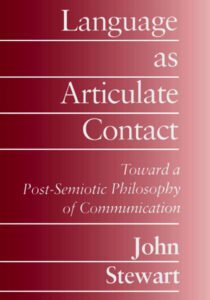 Overview
Overview
Language helps define us as human. For most of us, it’s one of the most common, ordinary, and yet powerful capabilities that we naturally develop. When deafness, blindness, or some other disability interferes with language development, people really suffer. And yet, over many centuries, scientists and philosophers have struggled to describe what language is and exactly how it works. Language as Articulate Contact contributes to this conversation. The book is written for scholars and students, and its basic ideas are applied in everything else I’ve written.
In this book, I show how the dominant view that language is a “system of symbols” is flawed in several ways, and I describe how language can better be understood as the way humans make articulate contact with one another. As social beings, humans are basically about making contact, and the main way we connect is with verbal/nonverbal language. The term “articulate contact,” highlights the difference between a hug and a conversation. A hug can say “Yes!” “I’m here for you!” or “I care.” But contact that’s articulate makes distinctions and can be organized into a meaningful whole. So a conversation can explain how to change a bicycle tire, create a listserv, or review the history of the Arab-Israeli conflict.
The subtitle is Toward a Post-Semiotic Philosophy of Communication. This tells you two things; first that the book philosophizes about communication, which means that it examines presuppositions, or basic beliefs that people have about what communication is and how it works. Secondly, the term “post-semiotic” means that I try to move beyond (“post” or “after”) treatments of language as a system of signs or symbols. The companion volume, Beyond the Symbol Model: Reflections on the Representational Nature of Language explicitly pursues this goal.
What’s the point of doing this? When language is understood to be a way of connecting, the focus of language study shifts to actual practices, effects, results, and concrete outcomes of all the language moves people make—descriptions, requests, proposals, accusations, reflections, inquiries, negotiations, etc. So this understanding of language is much more concrete than the one it replaces.
The old view also treats language as a tool that’s separate from us, and this view treats language as our main way of being who we are. The old view focuses attention on structure and this one emphasizes function—what we do in our talking and listening, writing and reading.
Chapter Summaries
Chapter 1 describes “the symbol model,” which for over 2000 years has been the prevailing and dominant view. The symbol model consists of five commitments: (a) that there are two worlds, one that’s linguistic and the other that’s nonlinguistic, (b) that these worlds can best be understood as atomistic, i.e., made up of small units (phonemes, words, morphemes, rules, etc.), (c) that the relationship between the two worlds is representational, i.e., that linguistic units represent units in the nonlinguistic world, (d) that language is a system not an activity or way of being, and (e) that language is a tool humans use in various ways. The chapter describes several problems with this model; for example, that it cannot be applied to living conversation, the most natural and frequent place where language happens.
Chapters 2 and 3 trace the history of the symbol model from Greek philosophers like Plato and Aristotle to several important 20th century language scholars, including C.S. Peirce, Ferdinand de Saussure, Ludwig Wittgenstein, and Suzanne Langer. These chapters demonstrate that all 5 elements of the symbol model have been affirmed by very influential thinkers over many centuries of language study.
Chapter 4 describes how language can usefully be viewed as articulate contact. I explain that there is not a linguistic world separate from a nonlinguistic one, because humans collaboratively construct worlds in their verbal/nonverbal articulate contact. The chapter cites the works of several thinkers who share this view, including philosophers Martin Heidegger and Hans-Georg Gadamer and Russian literary theorist Mikhail Bakhtin. I explain that language not just, and not mainly representational, but that it is constitutive—it is the way humans construct or bring-into-being the worlds of meaning that we inhabit. At the end of the chapter, I illustrate how this way of understanding language works much better than the symbol model to help us comprehend everyday conversation.
Chapter 5 demonstrates that this view of language as articulate contact is affirmed by thinkers in several disciplines. I review the criticism of representationalism found in the works of several postmodern scholars who study what they call the hermeneutics of intersubjectivity. Then the chapter shows how some deaf educators are changing their approach to deafness by understanding language as articulate contact. The next section examines some late 20th century work in Artificial Intelligence that also understands language as constitutive rather than representational.
The final 3 chapters of the book examine treatments of language by some Russian literary theorists, U.S. language philosopher Kenneth Burke, and Purdue’s philosopher of communication Calvin O. Schrag, to show how, in each case, these influential thinkers moved partly toward this view, without embracing it completely. These chapters illustrate how thinking about language could be enhanced by conceiving it as verbal/nonverbal articulate contact.
Read It Or Not?
As I said, Language as Articulate Contact is written for scholars and students. If you’re interested in language philosophy or literary theory, you might appreciate it. The view of language it criticizes—that language is a system of symbols—shows up in books about child development, language arts teaching, deaf education, English literature, communication, and several other disciplines.
But if you’re mainly interested in how language and communication work in everyday life, this isn’t the best book for you. It’s pretty abstract and some of the literatures it cites are a little dense.



